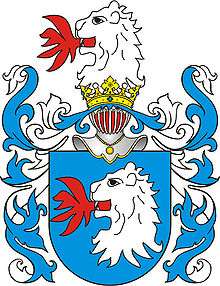Stanislovas Kęsgaila
Stanislovas Kęsgaila Jonaitis (Polish: Stanisław Janowicz Kieżgajło; died 1527) was a Lithuanian nobleman, son of Jonas Kęsgaila from the Kęsgailos family. Stanislovas Kęsgaila was the Elder of Samogitia (1486–1522), Grand Hetman of Lithuania (1501–1502), castellan of Trakai (1499–1522) and Vilnius (1522–1526).[1]
In 1494, he signed a peace agreement with the Grand Duchy of Moscow. The treaty was reinforced with engagement of Grand Duke of Lithuania Alexander Jagiellon and Helena, daughter of Ivan III. As the groom was away in Lithuania, his role was performed by Kęsgaila.[2]
At the start of the Russo-Lithuanian war of 1500–1503, Lithuanians suffered a major defeat in the Battle of Vedrosha.[3] Great Hetman (army commander) Konstanty Ostrogski was captured and was replaced by Semyon Olshanski who had gained military experience during the Polish–Ottoman War (1485–1503). But Olshanski was quickly replaced by Kęsgaila who had no prior military experience. Such appointment is difficult to explain, but possibly it was a result of diplomatic negotiations that ended in a military alliance with the Livonian Order.[3] Kęsgaila brought Lithuanian army to help the besieged Mstislavl and Smolensk, but in both cases the Russians retreated without a fight. He was replaced as Great Hetman by Stanisław Kiszka who distinguished himself in organizing Smolenk's defense.[3]
In 1505, he was expelled from the Lithuanian Council of Lords by Alexander Jagiellon for participation in the Union of Mielnik of 1501.[1] In 1516, during a border conflict, Kęsgaila commanded Samogitian forces, defeated the Teutonic Order, and captured Katyčiai.[4] However, Albert, Duke of Prussia, recaptured the village a few months later.[5]
Family
His main patrimonial property was in Kražiai.[6] Stanislovas was married three times to daughters of local nobles – twice to daughters of Alekna Sudimantaitis and once to a daughter of Svirsky. He fathered three sons Mykolas, Jonas, and Stanislovas Kęsgaila and at least one daughter Barbara who married Jan Janowicz Zabrzeziński.[6] Kęsgaila died in 1527 and was buried at Vilnius Cathedral.[4]
References
- 1 2 Zinkus, Jonas; et al., eds. (1985–1988). "Kęsgailos". Tarybų Lietuvos enciklopedija (in Lithuanian). II. Vilnius: Vyriausioji enciklopedijų redakcija. p. 298. LCC 86232954.
- ↑ Petrauskas, Rimvydas; Jūratė Kiaupienė (2009). Lietuvos istorija. Nauji horizontai: dinastija, visoumenė, valstybė (in Lithuanian). IV. Baltos lankos. p. 463. ISBN 978-9955-23-239-1.
- 1 2 3 Jankauskas, Vytas (2008). "Stanislovas Jonaitis Kęsgaila". In Surgailis, Gintautas. Lietuvos krašto apsaugos ministrai ir kariuomenės vadai (in Lithuanian). I. Lietuvos Respublikos krašto apsaugos ministerija. pp. 48–52. ISBN 978-9986-738-96-1.
- 1 2 Jasas, Rimantas (2006-01-17). "Kęsgáila Stanislovas". Visuotinė lietuvių enciklopedija (in Lithuanian). Mokslo ir enciklopedijų leidybos centras. Retrieved 10 March 2018.
- ↑ Dundulis, Bronius (1969). "Lietuva ir Ordino valstybės žlugimas" (PDF). Istorija. Mokslo darbai (in Lithuanian). 10: 164. ISSN 1392-0456.
- 1 2 Petrauskas, Rimvydas (2003). Lietuvos diduomenė XIV a. pabaigoje – XV a. (in Lithuanian). Aidai. pp. 254–255. ISBN 9955-445-67-X.
